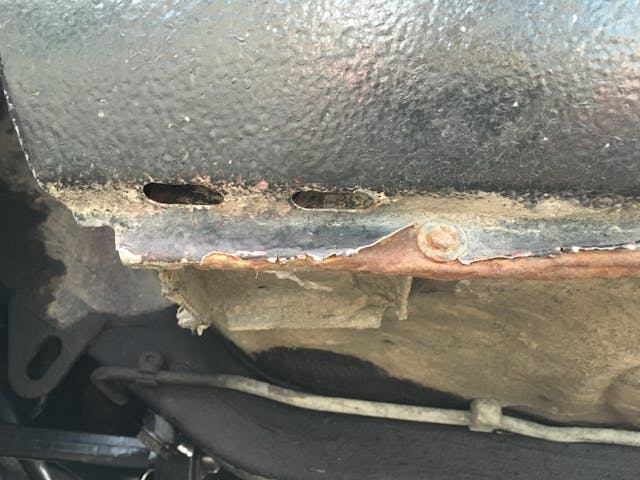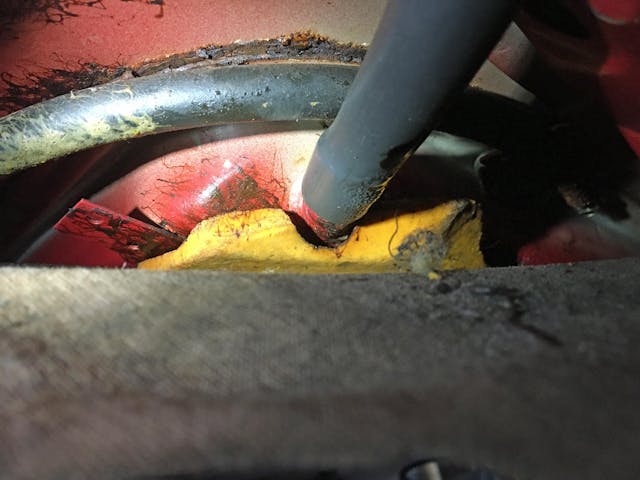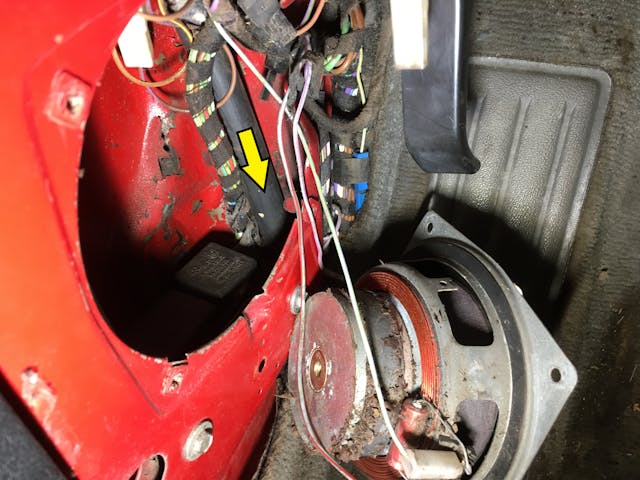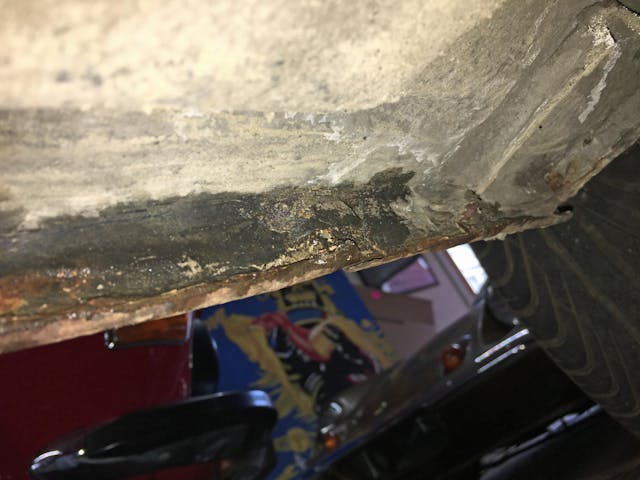Why I Dislike Sunroofs (Part II)
Last week, I fixed the stuck-and-leaking sunroof in my rebuilt salvage BMW “FrankenThirty” by epoxying a broken section of the plastic lifting mechanism and installing generic closed-cell foam weatherstripping that seemed to fit perfectly. I also ran a stiff wire down the front two drains and blew them out with compressed air. The total cost was zero. I was insufferably pleased with myself.
In triumph, knowing that rain was predicted, and for a final pat-on-the-back-know-that-I-nailed-it test, I left the car in the driveway overnight. In the morning, I found water dripping from the headliner, puddles on the seats, and wet spots on the carpet.

So what went wrong?
Two things. And it got worse before it got better.
The first one was a dumb oversight on my part. In addition to the sliding sunroof panel, there’s the rectangular section of the headliner that attaches beneath it and slides along with it. To remove the sunroof, you need to detach the headliner panel and slide it back so you can access the bolts holding the sunroof to the track, then slide it forward when you’re done. I did that, but I hedged my bets and didn’t snap the headliner panel back in place. This left the rear part of it sitting behind the back of the sunroof panel. The water got past the seal (as it normally may), but instead of all of it dripping into the trays in the moat, the back edge dripped onto the headliner panel, and from there into the car. I’m virtually certain this is what happened, because when I slid the headliner panel forward, the whole thing was soaked.

The next thing involved me massively exacerbating an existing problem, but likely had nothing to do with any of the water.
As I said last week, every sliding metal sunroof installed in a car since the 1970s is surrounded by a tray that’s basically a four-sided moat with a drain spout at each of the corners with hoses attached to them. The front two drain hoses run down the A-pillars, the rear two out the C-pillars. These hoses may emerge through the corners of the wheel wells, or they may stop short and dump the water into the rockers and sills. Sometimes there are dedicated holes for the water to run out, sometimes the drain holes get clogged, and sometimes, as with the rear drains in sunroof-equipped BMW 2002s from the 1970s era, there are no drain holes, and water just sits and rots things out from the inside.
Since sections of the rug were wet, it seemed likely that there was a drainage issue, so I directly tested the four corner drain spouts by pouring water down each one. My driveway slopes slightly downward, so I tested the front ones first. Water poured down the right front immediately produced a stream from near the front of the rocker panel, but the left front drain only yielded a few drips. The front drain holes in an E30 are obvious, so I cleaned them out with a coat hanger and repeated the test, but no water came out of them, just a couple of drips a few inches further back.

I swung the car around in the driveway, angling it nose-up to test the rear drains. They’re far enough back that you can’t easily reach them to run a wire down them, but I could certainly pour water down the left and right moats so that it ran in their direction. I was surprised that the water came out from behind the plastic trim of the rear bumper, but a quick check online showed that that’s where the rear drains emerge.
So, back to the left front drain. I redid the test, this time pouring almost a quart of water down it. I crouched down in front of the car and could see that water was now dripping from beneath it, but it seemed to be coming more from the front of the floor pan than the rocker panel. I looked inside the car and was surprised to see the base of the accelerator pedal surrounded by water, and the driver’s side rug soaked. This was far more severe than the few wet spots on the rug I’d initially seen.
Well, crap.
My first thought went back to the leaky sunroof on my Nissan Armada. There, the cause was that the hose had detached from the right front corner of the sunroof drain, causing a fair amount of water to leak down that A-pillar. I did what I did on the Armada, which was to arthroscopically expose that corner of the sunroof by pulling down just enough of the headliner to see it. In doing so, I came face-to-face with a pretty good-sized mouse nest.

After the detour to deal with the nest, I looked at what I came to see, and found nothing wrong with the hose attachment at the left front corner.

I wanted to see for myself where the bottom of this hose was, so I removed the kick panel at the lower left corner of the driver’s footwell. The hose was right there, hanging down into the sill, though ending perhaps not as far down as I would’ve expected. I had one of my kids pour water into the drain while I verified that the water actually came out of the bottom of the hose. It did, but only barely. Instead, more water pooled around the accelerator. Why wasn’t it draining properly?

I took a coat hangar and poked it up through the drain holes at the bottom of the front fender. Despite reaching inside the sill (where the end of the hose was) with my hand and looking with a flashlight, I could not find the other end of the hanger. I began to wonder if the path between the two had been blocked by boodged-up bodywork that accompanied the resurrection of the FrankenThirty from its salvage-title status 32 years ago. I removed the plastic liner of the inner fender so I could see the other side of the drain holes and came to a startling conclusion:
My decades-long belief that these two clearly visible oblong holes at the base of each front fender are sunroof drain holes (and it’s not just me; they’re referred to as sunroof drain holes all over the web) is simply wrong. They are in fact not sunroof drain holes. They drain any water that makes it past the plastic fender liner.
So where the hell are the sunroof drain holes?
I had to dig surprisingly deep on an E30 forum to find the answer. They’re two small openings in the weld between the inner and outer sills (the rocker panel). One is near the door hinge, the other is about 2/3 of the way back. They’re not visible unless you jack up the car, stick your head under, and look outward. Even if you do, they’re not easy to see. They clog easily, and they can easily be mistakenly sealed up during bodywork by someone who doesn’t know they’re there.
The rear one was plainly visible. I poked the coat hanger up it, and water gushed out.

The front one, however, took me a while to find. It looked like someone had jacked up the car by the door sill (something I avoid doing), and the action had partially folded up the lower part of the outer rocker.


This one was also completely clogged up. I cleaned it out, put an extension on the rubber hose so it emptied just in front of it instead of several inches above it, tested it, and water flowed freely.
I never got to see the exact path by which the water I was pouring down the sunroof drain overflowed the non-draining sill and wound up on the floor, but it didn’t matter. There may have been some amount of water intrusion by this method during the years the car sat outside with a sunroof that was neither fully closed nor sealed, but it’s almost certain that the unnaturally large quantities of water I was pouring for testing purposes created its own problem—that is, I caused water to pool at the base of the accelerator pedal and soak the rug. The wet spots on the rug I saw after the car had sat outside overnight were almost certainly from water dripping from above due to the mispositioned headliner panel.
It’s certain to rain again. We’ll see whether I’ve nailed this one shut or not.
Still not a fan of sunroofs.
***
Rob’s latest book, The Best Of The Hack Mechanic™: 35 years of hacks, kluges, and assorted automotive mayhem, is available on Amazon here. His other seven books are available here on Amazon, or you can order personally inscribed copies from Rob’s website, www.robsiegel.com.



Regular old sunroofs I can take or leave, but absolutely love the giant sliding glass panels found on today’s cars. Also a fan of targa tops and cloth-covered sunroofs, ala Lancia Montecarlo/Scorpion.
I bought an ozone generator to deal with organic smells aka water musty smells. Put in car close door and leave for 24 hours unplug leave for a couple hours air out , sone
I love convertibles, and T-tops are ok when a convertible isn’t an option. I hate sunroofs and I wish my car didn’t bundle the sunroof with my must-have options. If a tree ever falls on the roof, it’ll get replaced by one with no hole!